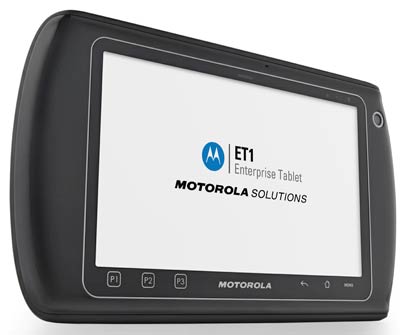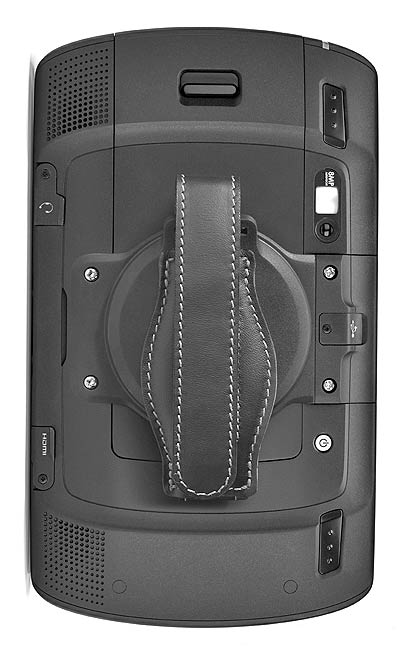|
Zebra ET1 Enterprise Tablet
Business-oriented, rugged Android-based 7-inch tablet with capacitive multi-touch
(by Conrad H. Blickenstorfer)
On October 10, 2011, Motorola Solutions, the enterprise division of which is now part of Zebra, introduced a potentially very significant product: its first new era, post PC enterprise-oriented tablet — wide-format 7-inch form factor, capacitive multi-touch, Android operating system, sensors and cameras and all. The new ET1 tablet, which despite being quite rugged weighs just 1.4 pounds, should be available this year.
Below you can see what the new Motorola Solutions ET1 looks like. Clearly, Motorola didn't just copy consumer tablets. The new ET1 has a design, and functionality, of its own.

Before we get into a brief discussion, here's the basic 411: The new ET1 measures 8.8 x 5.1 x 0.97 inches. That's a footprint considerably smaller than any netbook. Its weight of 1.4 pounds is about that of an iPad, not bad at all for an enterprise class device built to handle 4-foot drops. The 7-inch wide-format display has 1024 x 600 pixel WSVGA resolution, the same that worked just fine for tens of millions of netbooks. Capacitive multi-touch means the ET1 is as easy and effortless to operate as any Android-based smartphone.
Sheldon Safir of Motorola Solutions explained that while there's a media tablet explosion on the consumer side, on the vertical side it's still been mostly just concepts. Motorola is changing that with the ET1, which was designed from the ground up for enterprise and vertical market applications. That meant:
- Handy size and weight because workers may carry the tablet around all day.
- Inherent ruggedness — the ET1 can handle multiple drops, vibration, it has a wide operating temperature range (32 to 122 degrees Fahrenheit), and it's generally built to the same ruggedness standards as Motorola Solution's other ruggedized handhelds. And the display is protected by an extra-thick layer of Corning's Gorilla glass (see Corning Gorilla glass page).
- Security — there are different security requirements than for consumer tablets; the ET1 has 256-bit security, multi user logins, download control, etc., to keep credit card and other confidential data secure, both on-board and on removable media.
- Convenience — the battery lasts a full shift and it's easily replaceable; a special carry strap allows portrait or landscape use; a special expansion port accommodates snap-on peripherals; and there's an array of accessories to expand and customize functionality. Plus users get three programmable buttons in addition to the four standard Andoid buttons.
- Data capture — the ET1's 8-megapixel rear camera supports 1D/2D scanning and there are peripherals such as a card reader (see picture below right).
Below is a close-up of the backside of the ET1 with its special rotating carry strap, the protected ports (audio, HDMI, micro-USB), the rear camera, the battery compartment door, and what appears to be two trigger buttons.

Now what does all of this mean? Is Motorola Solutions on the right track? There is no clear answer to that yet. Panasonic pre-announced an Android-based enterprise/vertical market tablet in June of 2011, and that one uses the the larger 10.1-inch screen, 4:3 aspect ratio form factor pioneered by the iPad and also used by Motorola Mobility's Xoom tablet. And while Android has firmly established itself as the by-far leading alternative to Apple's iOS platform used in the iPhone and iPad, Android to-date has not seen nearly the same success in tablets.
From a technology point of view, ever since the advent of the iPad, vertical market manufacturers have argued that projected capacitive multi-touch was not suitable for vertical applications because it can't handle rain or gloves. We only agree to an extent. And for now, despite IP54-sealing and a good degree of ruggedness, Motorola clearly positioned the ET1 for retail deployments. The ET1 is also up to par in the whistles and bells department with a competent 1GHz TI OMAP4 processor, dual multi-function cameras (720P front, 8mp rear), HDMI output, sensors (motion, gyro, light, e-compass), connectivity (USB, expansion port, microSD card slot) and wireless (Bluetooth, WiFi, autonomous GPS).
Much will come down to the availability of software applications that are not only suitable for the task, but also take full advantage of the capacitive multi-touch interface. Motorola apparently offers a roster of "enterprise-grade" applications for task assigning, assisted selling, item location, manager dashboard, etc. And, together with the ET1, Motorola announced its new RhoElements open-source platform that allows developers to build and customize applications and integrate them seamlessly across Motorola enterprise devices with different operating systems (Android as well as Windows Embedded Handheld 6.5, Windows Embedded CE 5 and 6 and Windows Embedded Compact 7).
You never know in this market. Safir pointed out that Motorola Solutions (Symbol back then) once before introduced a tablet computer, the PPT-4100 of the early 1990s. That machine, which incidentally weighed the same 1.4 pounds as the new ET1, turned out to be ahead of its time, but it accurately predicted where the market was going. The ET1 plays a similar pioneering role, but the market is now such that, if the price is right, the ET1 may well address the pent-up demand caused by the unavailability of a suitable next-gen small tablet solution for vertical markets.
Update June 22, 2012: Motorola Solutions made available as options for the ET1 a scan module, a scanner/magnetic stripe reader module, a hip holster, and a protective rubber bezel.
|



